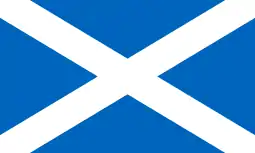Mòd
A mòd is a festival of Scottish Gaelic song, arts and culture.[1] Historically, the Gaelic word mòd (Scottish Gaelic: [mɔːt̪]), which came from Old Norse mót, refers to any kind of assembly.[2] There are both local mòds, and an annual national mòd, the Royal National Mòd. Mòds are run under the auspices of An Comunn Gàidhealach.[3] The term comes from a Gaelic word for a parliament or congress in common use during the Lordship of the Isles.
| Part of a series on the |
| Culture of Scotland |
|---|
 |
| History |
| People |
| Cuisine |
| Religion |
| Art |
| Literature |
|
A Mòd largely takes the form of formal competitions. Choral events (in Gaelic, both solo and choirs), and traditional music including fiddle, bagpipe and folk groups dominate. Spoken word events include children and adult's poetry reading, storytelling and Bible reading, and categories such as Ancient Folk Tale or Humorous Monologue. Children can also present an original drama, and there are competitions in written literature. Unlike the National Mòd, local mòds usually only last a day or two. They attract a much smaller crowd and the only notable social event is the winners' ceilidh. As there are fewer competitions than in the National Mòd, this ceilidh is often more like a traditional ceilidh with dancing and guest singers between the winners' performances.
Culturally, mòds are comparable to an Irish Feis (although Scotland also has its own fèisean and fèis movement) or the Welsh eisteddfod, but without the ancient roots or the fanciful nineteenth-century "druidic" pageantry of the National Eisteddfod of Wales.
List of mòds
- Royal National Mòd
- Caithness and Sutherland Mòd
- Dalriada Mòd (Lochgilphead area)
- Easter Ross Mòd
- East Kilbride Mòd
- Edinburgh Mòd
- Glasgow Mòd
- Harris Mòd
- Inverness Mòd
- Islay Mòd
- Kyle Mòd
- Lewis Mòd
- Lochaber Mòd
- Oban Mòd
- Mull Mòd
- Perthshire and Angus Mòd
- Skye Mòd
- Stirling Mòd
- Uist Mòd
- Wester Ross Mòd
- Ardnamurchan Mòd
See also
| Wikimedia Commons has media related to Mod (Scotland). |
References
- Koch, John T. (2006). Celtic culture: a historical encyclopedia. Vol. 1-. ABC-CLIO. p. 472. ISBN 9781851094400.
Despite these shortcomings, the Mod retains a flagship status and is recognized throughout Scotland as a manifestation of Gaelic culture.
- Lynch, Michael (2007). The Oxford Companion to Scottish History. Oxford University Press. p. 425. ISBN 978-0199234820.
- Koch, John T. (2006). Celtic culture: a historical encyclopedia. Vol. 1-. ABC-CLIO. p. 471. ISBN 9781851094400.
External links
- An Comunn Gàidhealach with information about the Royal National Mòd and provincial Mòds
- Picture